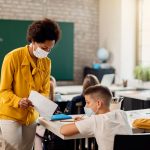A study co-authored by Neag School doctoral candidate, Robert Cotto, and former faculty member Sarah Woulfin, is featured. A survey of more than 150 parents whose children attend school in Hartford found that child care needs and concerns about the effectiveness of schools’ COVID-19 safety measures strongly impacted whether or not families sent their children back to school buildings for in-person learning in fall 2020.
Even before COVID-19, as many as 1 in 6 young children had a diagnosed mental, behavioral or developmental disorder. New findings suggest a doubling of rates of disorders such as anxiety and depression among children and adolescents during the pandemic. One reason is that children’s well-being is tightly connected to family and community conditions such as stress and financial worries.
After more than a year of restrictions and online schooling, educators and counselors are focusing on ways to assess the long-term social, emotional and mental impact of the pandemic on school children when they return to the classroom. Christopher Booker reports from Fairfield County, Connecticut as part of our ongoing series, “Roads to Recovery.”
School Counselors Leading the Way: Helping to assist students in their school adjustment, academic performance, and mental health in a post-pandemic school setting
“Learning is never lost, though it may not always be ‘found’ on pre-written tests of pre-specified knowledge or preexisting measures of pre-coronavirus notions of achievement.” – Rachael Gabriel, Associate Professor of Literacy Education at the University of Connecticut.
Throughout my teacher preparation program at UConn’s Neag School of Education, I always knew that my first year of teaching would be challenging. However, I never could have imagined the challenges that the year 2020-2021 has brought. This year has brought students in masks with shields over their desks, hybrid learning, block schedules, fully online students, and the struggle to keep students engaged despite the uncertainty of their outside world. All of the teaching and classroom management strategies that I learned in my teacher preparation program now seemed distant as all teachers learned how to adapt and teach in this new learning model.
Creative activities served as a buffer that helped many older adults cope with isolation, stress and fear during the pandemic, according to James C. Kaufman of the Neag School of Education at the University of Connecticut, Storrs. He points to research that suggests that participation in arts—crafts as well as dance, singing or painting—helps increase social engagement, stave off depression and keep older adults mentally engaged and active.
Virtual classrooms may become a permanent fixture in the state of Connecticut. New legislation tasks the state’s Department of Education to develop plans for a K-12 statewide remote learning school that would use the same curriculum and have the same school year length as a traditional school, but would be under the jurisdiction of the State Board of Education.
It was coming home,” U.S. Secretary of Education Miguel Cardona ’01 MA, ’04 6th Year, ’11 Ed.D., ’12 ELP said of heading to Pratt & Whitney Stadium at Rentschler Field to give this year’s commencement address. Students could not have agreed more. At a string of outdoor ceremonies May 8–12, students and families gathered together for the first time in many long pandemic months.
Dr. Violet Jiménez Sims, the associate director of teacher education at Neag, said that education students could meet some of the demand for teachers. Her five-year program partners with 13 districts in the state, and she said that many of these districts hire their graduates. Dr. Niralee Patel-Lye, who directs Neag’s accelerated teacher certification program, said the department recently piloted a program that places students in full-time teaching positions.


